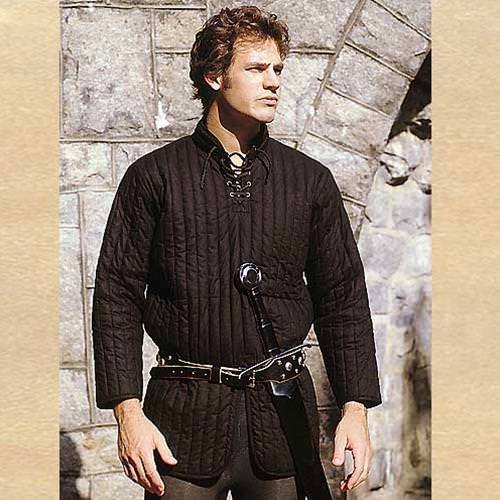Glen K wrote:I'm doing it in an attempt to learn more about the relationship between fit, padding, and mobility for 11/12th century armour. I'm not sure I'd classify that as "costume," but it's certainly not for SCA sport combat.
Huzzah!
if I may add to this discussion, my key timeframe in experimental archaeology is late 12th early 13th century. Again, as discussed earlier, in my own research of primary and secondary forms of research it is quite lacking. But, as a whole, it seems they started to wear a three piece under-layer, most notably the Knights Hospitaller and the Knights Templar in chronicles. What we do know from documents of both sides, is these men could ride into battle, fight on, and if lucky ride out looking like a pin cushion.
In my own experience thus far, having based nothing on anyone else's work, what seems to work the best, and fit the profile of the period appears to be this:
inner layer of padding (I'll call this one the aketon)
this layer, for me anyways, is highly mobile yet not having the highly tailored look of the later period pourpoints. It's all in the armpit and shoulders, and matches the gores of period textile non-armour garments (think, period t-tunic). This layer also has very, very fine channels, about 3/4" and only has about an 1/8" of padding, except the elbows which is done only for my re-enactment group (not SCA), which are an added layer, so about 1/4" of padding.
middle layer - period hauberk with integral coif and ventail, and integral mittens
this layer, I'm still constructing, which if anyone has made mail before, and I know some of you have, yeah, that's going to be a while. My materials, are 17ga annealed rebar wire, about the closest, affordable, and easy to get thing I could find that's similar to period iron maile. I believe it's key the metal is malleable, to protect from the cutting and percussive blows.
outer layer of padding (I'm calling this one the gambeson)
this layer has fairly deep armpits with broad shoulders in the back and a narrower (not by too much) chest. best way I can describe this easily here is a schematic looking from above of: /O\ basically the O is the hole for the head and the slashes being the arm holes. This garment is 1/4 - 5/8" thick depending on the area, I added a bit to my injured spots on my person and for back/kidney protection, basically think a back brace worth of an extra layer of batting. These channels are heavily lofted in comparison to the gambeson, being the channels are 2".
This garment, as far as wearing the two padded layers and borrowing a hauberk for a bit, feel a lot lighter than they weigh. I'm also used to carrying a ton of weight myself, I played sousaphone in school and have worked construction. Using shinai, wooden wasters, and Rawlings synthetics, it works admirably. The wooden wasters, I feel the shot and know it, the other two, I just feel it. I'm sure rebated steel would be similarly between the wooden wasters and rawling synthetics depending on the manufacturer.
I don't know how historically accurate all this is, minus, thankfully 50 years later we do have evidence of these layers and how they were made, and it's all machine sewn with cotton "warm & natural" batting... so it's not remotely accurate to the period anyways in regards to construction minus the overall "look." But it looks and feels amazing, and highly mobile. The fact is, if it didn't work, they'd have gone with something else. If it doesn't seem to work well for us, it's safe to say we're wrong in our execution.
"Never theorize before you have data. Invariably, you end up twisting facts to suit theories, instead of theories to suit facts." - Sherlock Holmes ~ Sr Arthur Conan Doyle

